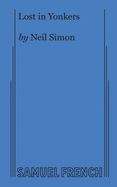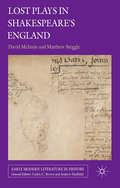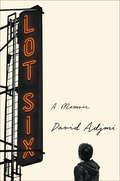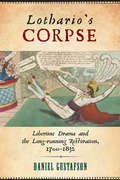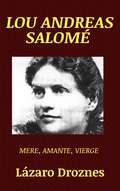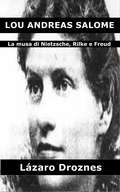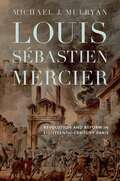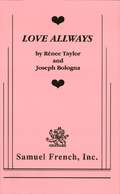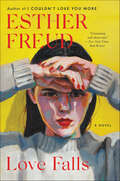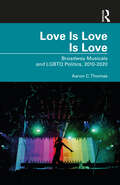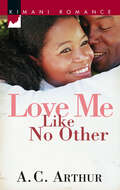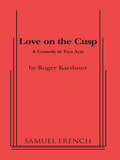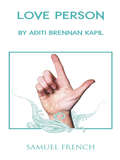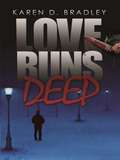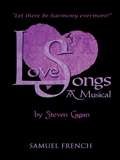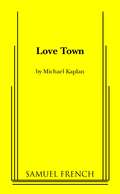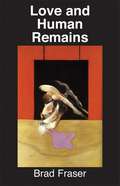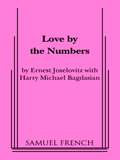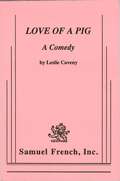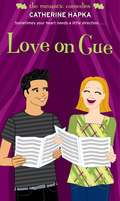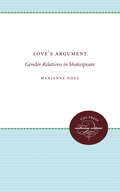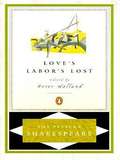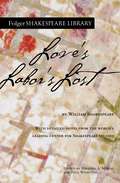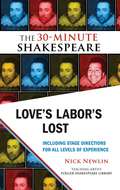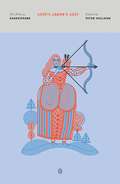- Table View
- List View
Lost In Yonkers
by Neil Simon"Neil Simon has done it again, with a craftmanship and skill probably unmatched in the contemporary English-speaking theater." --Clive Barnes, New York Post <P><P>What happens to children in the absence of love? That is the question that lies at the heart of this funny and heartrending play by one of America's most acclaimed and beloved playwrights. Winner of four Tony Awards, including Best Play, and the Pulitzer Prize, Lost in Yonkers is Neil Simon's moving drama about the cruelties and painful memories that scar a family. It is New York, 1942. After the death of their mother, two young brothers are sent to stay with their formidable grandmother for the longest ten months of their lives. <P><P>For Grandmother Kurnitz is a one-woman German front--a refugee and a widow who has steeled her heart against the world. Her coldness and intolerance have crippled her own children: the boys' father has no self-esteem . . . their Aunt Gert has an embarrassing speech impediment . . . their Uncle Louie is a small-time gangster . . . and their Aunt Bella has the mentality of a child. But it is Bella's hunger for affection and her refusal to be denied love that saves the boys--and that leads to an unforgettable, wrenching confrontation with her mother. Filled with laughter, tears, and insight, Lost in Yonkers is yet another heartwarming testament to Neil Simon's talent.
Lost Plays in Shakespeare’s England
by David Mcinnis Matthew SteggleLost Plays in Shakespeare's England examines assumptions about what a lost play is and how it can be talked about; how lost plays can be reconstructed, particularly when they use narratives already familiar to playgoers; and how lost plays can force us to reassess extant plays, particularly through ideas of repertory studies.
Lot Six: A Memoir
by David Adjmi“David Adjmi has written one of the great American memoirs, a heartbreaking, hilarious story of what it means to make things up, including yourself. A wild tale of lack and lies, galling humiliations and majestic reinventions, this touching, coruscating joy of a book is an answer to that perennial question: how should a person be?” — Olivia Laing, author of Crudo and The Lonely CityIn a world where everyone is inventing a self, curating a feed and performing a fantasy of life, what does it mean to be a person? In his grandly entertaining debut memoir, playwright David Adjmi explores how human beings create themselves, and how artists make their lives into art. Brooklyn, 1970s. Born into the ruins of a Syrian Jewish family that once had it all, David is painfully displaced. Trapped in an insular religious community that excludes him and a family coming apart at the seams, he is plunged into suicidal depression. Through adolescence, David tries to suppress his homosexual feelings and fit in, but when pushed to the breaking point, he makes the bold decision to cut off his family, erase his past, and leave everything he knows behind. There's only one problem: who should he be? Bouncing between identities he steals from the pages of fashion magazines, tomes of philosophy, sitcoms and foreign films, and practically everyone he meets—from Rastafarians to French preppies—David begins to piece together an entirely new adult self. But is this the foundation for a life, or just a kind of quicksand? Moving from the glamour and dysfunction of 1970s Brooklyn, to the sybaritic materialism of Reagan’s 1980s to post-9/11 New York, Lot Six offers a quintessentially American tale of an outsider striving to reshape himself in the funhouse mirror of American culture. Adjmi’s memoir is a genre bending Künstlerroman in the spirit of Charles Dickens and Alison Bechdel, a portrait of the artist in the throes of a life and death crisis of identity. Raw and lyrical, and written in gleaming prose that veers effortlessly between hilarity and heartbreak, Lot Six charts Adjmi’s search for belonging, identity, and what it takes to be an artist in America.
Lothario's Corpse: Libertine Drama and the Long-Running Restoration, 1700-1832 (Transits: Literature, Thought & Culture 1650-1850)
by Daniel GustafsonLothario’s Corpse unearths a performance history, on and off the stage, of Restoration libertine drama in Britain’s eighteenth and early nineteenth centuries. While standard theater histories emphasize libertine drama’s gradual disappearance from the nation’s acting repertory following the dispersal of Stuart rule in 1688, Daniel Gustafson traces its persistent appeal for writers and performers wrestling with the powers of the emergent liberal subject and the tensions of that subject with sovereign absolutism. With its radical, absolutist characters and its scenarios of aristocratic license, Restoration libertine drama became a critical force with which to engage in debates about the liberty-loving British subject’s relation to key forms of liberal power and about the troubling allure of lawless sovereign power that lingers at the heart of the liberal imagination. Weaving together readings of a set of literary texts, theater anecdotes, political writings, and performances, Gustafson illustrates how the corpse of the Restoration stage libertine is revived in the period’s debates about liberty, sovereign desire, and the subject’s relation to modern forms of social control. Ultimately, Lothario’s Corpse suggests the “long-running” nature of Restoration theatrical culture, its revived and revised performances vital to what makes post-1688 Britain modern. Published by Bucknell University Press. Distributed worldwide by Rutgers University Press.
Lou Andrea Salomé: Mere, amante, vierge
by Lázaro DroznesLou Andrea Salomé est une femme qui a toujours intriguée de par sa capacité à inspirer trois grands hommes: Nietzsche, Rilke et Freud. Lou a été l'amante de Rilke, l'amie intime de Nietzsche et l'élève et la confidente de Freud. Une femme super-muse qui a inspiré ces hommes, relativement méconnus au moment de la relation. Cette fiction dramatique présente les relations de cette femme extraordinaire avec ces trois hommes extraordinaires afin de pouvoir réfléchir sur la nature de la femme et les mécanismes qu’elle utilise, la plupart du temps sans le vouloir ou sans s’en rendre compte, dans le but d’inspirer les hommes avec qui elle entre en contact.
Lou Andreas Salomé: La Musa di Nietzsche, Rilke, e Freud
by Lázaro Droznes Silvia NiroLou Andreas Salomé è una donna che ha sempre attratto per il suo ascendente su tre grandi uomini: Nietzsche, Rilke e Freud. Lou fu amante di Rilke, amica intima di Nietzsche e allieva e confidente di Freud. Una supermusa che ispirò questi uomini relativamente sconosciuti al momento della relazione. Quest'opera drammatica presenta le relazioni tra questa straordinaria donna e questi tre uomini fuori dal comune per poter riflettere sulla natura della donna e i meccanismi che utilizza, molte volte senza volerlo o senza rendersene conto, per ispirare gli uomini con i quali entra in contatto.
Louis Sébastien Mercier: Revolution and Reform in Eighteenth-Century Paris (Transits: Literature, Thought & Culture, 1650-1850)
by Michael J. MulryanFrench playwright, novelist, activist, and journalist Louis Sébastien Mercier (1740–1814) passionately captured scenes of social injustice in pre-Revolutionary Paris in his prolific oeuvre but today remains an understudied writer. In this penetrating study—the first in English devoted to Mercier in decades—Michael Mulryan explores his unpublished writings and urban chronicles, Tableau de Paris (1781–88) and Le Nouveau Paris (1798), in which he identified the city as a microcosm of national societal problems, detailed the conditions of the laboring poor, encouraged educational reform, and confronted universal social ills. Mercier’s rich writings speak powerfully to the sociopolitical problems that continue to afflict us as political leaders manipulate public debate and encourage absolutist thinking, deepening social divides. An outcast for his polemical views during his lifetime, Mercier has been called the founder of modern urban discourse, and his work a precursor to investigative journalism. This sensitive study returns him to his rightful place among Enlightenment thinkers.
Love Always
by Renee Taylor Joseph BolognaShort plays / These short plays, most no more than ten minutes, are by the authors of Lovers and Other Strangers, , Bedrooms and It Had to Be You. About the foibles and follies of love and lovers, some are excellent for college and high school performers and others are suited to older actors.
Love Falls: A Novel
by Esther FreudThe highly praised author of Hideous Kinky, returns with a searing and sensuous tale young love set amid the heat and beauty of a Tuscan summerThe Independent calls Esther Freud “the best writer on childhood we have.” In Love Falls this brilliant novelist proves her power once again with an utterly charming and irresistible tale of adolescent love and self-discovery set in a foreign land.When 17-year-old Lara accepts her father’s invitation to accompany him to Tuscany for the summer, she’s excited and trepidatious. But, her fears prove groundless, for the villa’s closest neighbors are the contagiously adventurous Willoughbys, the teenaged brood of a wealthy British lord. Caught up in their torrential good humor—and snared particularly by Kip Willoughby’s dark, flirtatious eyes—Lara sets off on a summer adventure full of danger, first love, and untold consequences that will change her life.
Love Is Love Is Love: Broadway Musicals and LGBTQ Politics, 2010-2020
by Aaron C. ThomasThe politics of Broadway musicals matter a great deal more to U.S. American culture than they appear to mean, and they are especially important to mainstream politics surrounding sex, gender, and sexuality. Love Is Love Is Love looks to the Broadway musicals of the past decade for help understanding the current state of LGBTQ politics in the United States. Through analyses of Promises, Promises, Newsies, Hedwig and the Angry Inch, The Color Purple, and Frozen, this book attempts to move past the question of representational politics and asks us instead to think in more complex ways about LGBTQ identity, what LGBTQ politics are, and the politics of Broadway musicals themselves. Producing new, complex readings of all five of these musicals, author Aaron C. Thomas places each of them within the context of the LGBTQ politics of their day. Some of the issues the book treats are controversies of casting, the closetedness and openness of musical theatre, LGBTQ identities, adaptation from movies into musicals, and the special power of the musical form by examining how these shows differ from the books and movies on which they’re based. Love Is Love Is Love places contemporary LGBTQ political tensions and conversations in a new light, making this an essential companion for students and scholars of contemporary theatre, musical theatre, cultural studies, Queer studies, and gender studies.
Love Me Like No Other
by A.C. ArthurTwo Can Play at This Game!Lincoln can’t believe it—that beautiful babe who owes his casino $5,000 is Jade. He’s never stopped thinking about her since that one hot night years ago. Now she’s in his debt! Of course, he doesn’t want her money….At first, Jade’s outraged—pose as his fiancée for one week or he’ll call the police! But then…how about some sweet revenge? So while he’s playing Mr. Seducer, she’ll be Miss Tease. Before the week is up, she’ll have him on his knees—just before she walks away! That is, if she can convince her heart she’s not still in love….
Love On The Cusp: A Comedy in Two Acts
by Roger KarshnerJerry comes unglued when his wife, Eleanor, an astrology nut, informs him they can't have sex for thirty days because her planet is in retrograde. Jerry and his sports loving buddy, Marvin, conspire against Eleanor's rip off advisor, Rhoda. But when Rhoda arrives on the scene, Marvin does a complete flip flop and falls for her instantly. Rhoda advises Eleanor that she's about to be visited by "an overpowering electric influence" which manifests itself in the person of Joe, handsome TV repairman. Eleanor falls for Joe who Jerry rightly spots as phony who's trying to get my wife's money on horizontal hold. Joe wins the moment and Jerry is forced out of the house into a crummy apartment. But Jerry the super salesman and manipulator deftly maneuvers the situation, rekindles Eleanor's love, awakens Marvin and exposes Rhoda and Joe.
Love Person
by Aditi Brennan KapilDramatic Comedy. 1m, 3f. Interior. Love Person is a four part love story in Sanskrit, ASL and English in which love transcends sexual orientation, physical attraction, and social structure and rests instead on the ways in which we communicate and how communication bonds or breaks us. The play is structured around four Sanskrit love poems that influence and reflect the journeys of the characters. Free, a Deaf woman in a relationship with Maggie, accidentally falls into a deceptive email correspondence with her sister Vic's love interest Ram, a Sanskrit professor. Free and Ram discover a connection, based largely on an affinity between their two languages. As a result of the deception, Vic and Ram also begin to fall in love. Meanwhile Free and Maggie's relationship struggles to survive. “Kapil’s Love Person is a fascinating brew of emotion, wit and intellect that challenges its audience to reassess how the form of communication shapes understanding.” —Lisa Brock, Minneapolis Star Tribune. “Startling and evocative!” —Michael Opperman, Twin Cities Daily Planet. “Heart-pounding attraction, intense all-night conversations - Aditi Brennan Kapil’s Love Person captures the giddiness of new love affairs. But the play is even more eloquently realistic about the wear and tear that time wreaks on relationships.” —Nicole Estvanik, American Theatre Magazine, July 2008
Love Runs Deep
by Karen D. BradleyAfter Tyler Bradford has a run in with the Chameleon, she finds herself gunned down and bleeding in the snow next to her best friend, Lorrain. Her entire world changes when Lorrain dies. She becomes determined to make the Chameleon pay for his crimes. However, she isn't the only one on a mission. The Chameleon is hunting her down to finish what he started. Their paths will cross, yet only one of them will accomplish their goal. Tyler's love for Lorrain runs deep, but will it be the very thing that gets her killed?
Love Songs
by Steven CaganMusical / Steven Cagan / 3m, 3f / Simple Sets / Love Songs is a truly extraordinary musical theatre experience, the return of romance to the stage! Believe in the healing power of love and romance once again. Steven Cagan's glorious work expresses the truth, beauty and hopefulness that we all strive for in this journey called life through the story of three couples. Jeremy is stuck out of town on a business trip for Roy's ad agency, trying frantically to get back in time for his nuptials. His betrothed, Gaby, is anxious for him to return. Sarah, who has been engaged to Ben for six years, is weary of his failure to commit to her. Ben has been idealizing a kind of love that does not really exist. Roy and Rose, lovers for many years, just enjoy themselves. How will their stories work out? Love Songs is timeless in its appeal. Let there be harmony evermore! "How wonderful...it really is terrific!" - Marvin Hamlisch "Truly, the harmonic color and lyrical poetry make this an extraordinary achievement."- Michael Feinstein "Love Songs - A Musical embraces essential contemporary relationships with humor and compassion. The songs are memorable, the stories are timeless." - Lynne Taylor-Corbett (Director/Choreographer & Tony Award nominee for Swing!)
Love Town
by Michael KaplanComedy 5m, 3f, Possible Cast Expansion / Interior Sea Spray is a charming beach town, perfect for romantic getaways and cliff-side proposals. While tourists walk around with stars in their eyes, the locals take their lumps and watch their relationships fray and fizzle. Karl is a self-professed good guy who bought the little village dream for his wife, only to have her run off with the town aromatherapist. Now he's stuck with a quaint souvenir shop he never wanted, and the vengeful impulse to run it into the ground. As the local merchants scheme to drive Karl away, his bitter emporium becomes a safe haven for the romantically scarred men of Sea Spray. "...Clever and funny, laced with jokes. A quirky adult comedy that will stand on its own in any community" - The Tribune "[Love Town] unmasks the truth that lies beyond artificial social niceties, revealing an authenticity behind the brightly painted facade that little towns display to the world." - New Times of the Central Coast
Love and Human Remains
by Brad FraserDavid McMillan is a former actor, current waiter on the verge of turning thirty. Together with his book-reviewing roommate, Candy, and his best friend, Bernie, David encounters a number of seductive strangers in their search for love and sex. But the games turn ugly when it appears one of their number might be a serial killer. A compelling study of young adults groping for meaning in a senseless world. Love and Human Remains was immediately controversial for its violence, nudity, frank dialogue, and sexual explicitness. It was quickly acclaimed by critics and audiences alike and was named one of the ten best plays of the year by Time Magazine. The play has been produced worldwide, translated into multiple languages, and received many awards.
Love by the Numbers
by Ernest JoselovitzComic romance \ Ernest Joselovitz with Harry Michael Bagdasian \ 5 m., 4 f. \ Int. \ Todd Dobson, computer honcho from New York City, is in the small town of Willowdale to install a computer system in Hiram Paige's library. He falls head over heels in love with the library assistant. Todd proposes right then and there and, to her own surprise, Harriet invites him home to face her family. Confronted with Harriet's boyfriend Mitch, sister Judith Ann's casseroles, grandmother Hortense who has her eye on Hiram, and a mother who never smiles, Todd realizes this isn't going to be easy. This lighthearted comedy about love in the computer age reminds us that laughter makes love sweet, that there are still large pleasure in small town life, and that a loving family can still make the most important word in the world "home."
Love of a Pig
by Leslie CavenyComedy / 4m, 4f to play 33 characters / Unit set / Jenny is a young violinist pleased with her life except for when it comes to men. Having spent 3,345 nights alone of a possible 3,356 since puberty, she approaches scientifically the question "Why not me?" The play chronicles her pursuit of a brooding bass player she mistakenly assumes is Mr. Right.
Love on Cue
by Catherine HapkaWhen you have to sing your heart out, it's best to know how.... Maggie Tannery is a true theater girl and a total shoo-in for the lead in this year's school production of Romeo and Juliet. She's seriously psyched because it looks like her crush, Daniel, might be playing her Romeo both on- and offstage -- if all goes as planned. But when her school decides to perform a musical instead, Maggie catches a major case of stage fright -- because she can't sing! With her lead role in jeopardy, as well as her chance of winning her leading man, Maggie turns to the musically talented Nico to give her voice lessons. But their voices aren't the only things that seem to be harmonizing. As Maggie tries to break a leg -- and not her heart -- she wonders who the music man of her dreams really is....
Love's Argument: Gender Relations in Shakespeare
by Marianne NovyNovy demonstrates how the plays are theatrical transformations of tensions in both ideals and practices in Renaissance society. Analyzing the dramatic images of lover and beloved, of husband and wife, of parent and child, Novy examines the ways in which the conflicts are resolved in the comedies and romances and how they are acted out in the tragedies. Chapters on individual plays provide original interpretations that delineate the tone and texture of gender relations.A UNC Press Enduring Edition -- UNC Press Enduring Editions use the latest in digital technology to make available again books from our distinguished backlist that were previously out of print. These editions are published unaltered from the original, and are presented in affordable paperback formats, bringing readers both historical and cultural value.
Love's Labor's Lost
by William Shakespeare Stephen Orgel A. R. Braunmuller"I feel that I have spent half my career with one or another Pelican Shakespeare in my back pocket. Convenience, however, is the least important aspect of the new Pelican Shakespeare series. Here is an elegant and clear text for either the study or the rehearsal room, notes where you need them and the distinguished scholarship of the general editors, Stephen Orgel and A. R. Braunmuller who understand that these are plays for performance as well as great texts for contemplation." (Patrick Stewart) The distinguished Pelican Shakespeare series, which has sold more than four million copies, is now completely revised and repackaged. Each volume features: * Authoritative, reliable texts * High quality introductions and notes * New, more readable trade trim size * An essay on the theatrical world of Shakespeare and essays on Shakespeare's life and the selection of texts
Love's Labor's Lost
by William Shakespeare Paul Werstine Dr Barbara MowatAt first glance, Shakespeare's early comedy Love's Labor's Lost simply entertains and amuses. Four young men (one of them a king) withdraw from the world for three years, taking an oath that they will have nothing to do with women. The King of Navarre soon learns, however, that the Princess of France and her ladies are about to arrive. Although he lodges them outside of his court, all four men fall in love with the ladies, abandoning their oaths and setting out to win their hands. The laughter triggered by this story is augmented by subplots involving a braggart soldier, a clever page, illiterate servants, a parson, a schoolmaster, and a constable so dull that he is named Dull. Letters and poems are misdelivered, confessions are overheard, entertainments are presented, and language is played with, and misused, by the ignorant and learned alike. At a deeper level, Love's Labor's Lost also teases the mind. The men begin with the premise that women either are seductresses or goddesses. The play soon makes it clear, however, that the reality of male-female relations is different. That women are not identical to men's images of them is a common theme in Shakespeare's plays. In Love's Labor's Lost it receives one of its most pressing examinations. The authoritative edition of Love's Labor's Lost from The Folger Shakespeare Library, the trusted and widely used Shakespeare series for students and general readers, includes: -Freshly edited text based on the best early printed version of the play -Full explanatory notes conveniently placed on pages facing the text of the play -Scene-by-scene plot summaries -A key to the play's famous lines and phrases -An introduction to reading Shakespeare's language -An essay by a leading Shakespeare scholar providing a modern perspective on the play -Fresh images from the Folger Shakespeare Library's vast holdings of rare books -An annotated guide to further reading Essay by William C. Carroll The Folger Shakespeare Library in Washington, DC, is home to the world's largest collection of Shakespeare's printed works, and a magnet for Shakespeare scholars from around the globe. In addition to exhibitions open to the public throughout the year, the Folger offers a full calendar of performances and programs. For more information, visit Folger.edu.
Love's Labor's Lost: The 30-Minute Shakespeare
by Nick NewlinLove's Labor's Lost: The 30-Minute Shakespeare plays three action-packed scenes from this tale of King Navarre and his three lords, who have vowed to retire from women for three years. Naturally, the Princess of France and her three ladies arrive, and comedic courtship ensues.The cutting includes the ridiculous dance of the lords disguised as Russians, the hysterical "Pageant of the Nine Worthies," and a dramatic, bittersweet ending that leaves the King and the three lords laboring for love.The edition includes a preface by Nick Newlin containing helpful advice on how to put on a Shakespeare performance in a high school class with novice actors, as well as an appendix with suggestions for the specific play and recommendations for further resources.
Love's Labor's Lost: Webster's Italian Thesaurus Edition (The Pelican Shakespeare)
by William Shakespeare Stephen Orgel Peter Holland A. R. BraunmullerThe acclaimed Pelican Shakespeare series edited by A. R. Braunmuller and Stephen Orgel The legendary Pelican Shakespeare series features authoritative and meticulously researched texts paired with scholarship by renowned Shakespeareans. Each book includes an essay on the theatrical world of Shakespeare’s time, an introduction to the individual play, and a detailed note on the text used. Updated by general editors Stephen Orgel and A. R. Braunmuller, these easy-to-read editions incorporate over thirty years of Shakespeare scholarship undertaken since the original series, edited by Alfred Harbage, appeared between 1956 and 1967. With definitive texts and illuminating essays, the Pelican Shakespeare will remain a valued resource for students, teachers, and theater professionals for many years to come. For more than seventy years, Penguin has been the leading publisher of classic literature in the English-speaking world. With more than 1,800 titles, Penguin Classics represents a global bookshelf of the best works throughout history and across genres and disciplines. Readers trust the series to provide authoritative texts enhanced by introductions and notes by distinguished scholars and contemporary authors, as well as up-to-date translations by award-winning translators.
